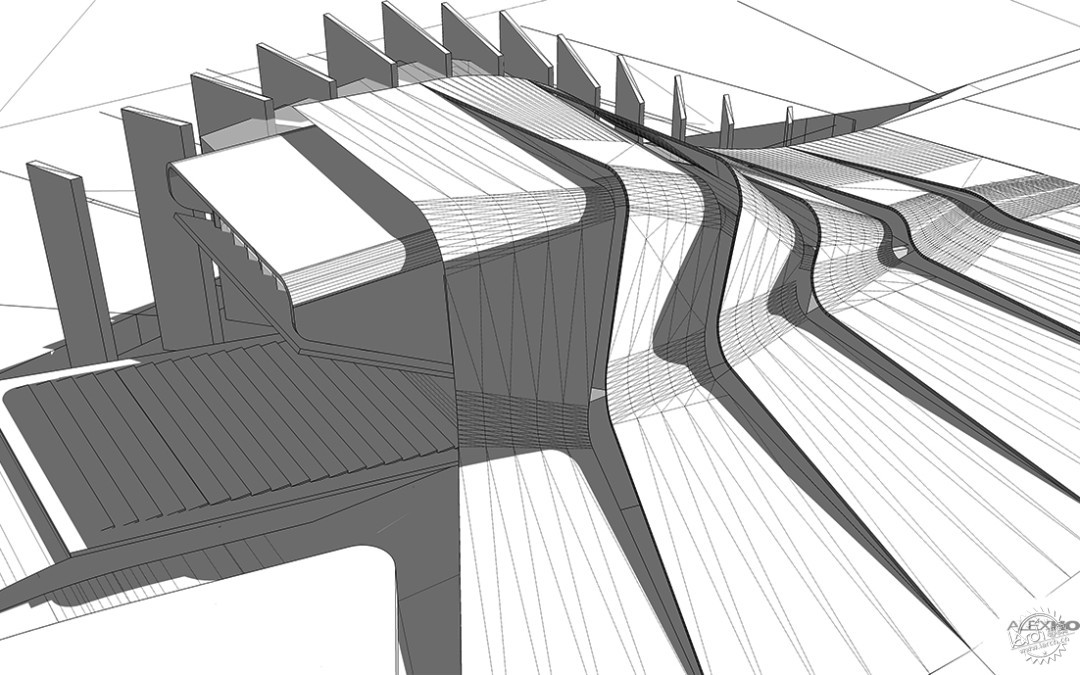
来自专筑编辑刘庆新的报道。我收到了许多评论,都是要求我解释怎么建模以及更加具体的解释弯曲的几何体。SketchUp 本身不适合建这种“有机”模型。你需要正确的插件去实现“rhino-esk”的功能。我在建这个模型的时候并没有进行复杂的考虑,但是任何复杂的模型都不应该用 SketchUp 来建模。像 Rhino 这样的软件则更加适合用来建这种模型,因为这些程序是使用NURBS基础 来建模的,取代了那些需要大量编辑性和手动完成的复杂几何体。在如下图模型的条件下,为了弥补SketchUp 和类似 Rhino 之类软件的功能差距,我开始用免费的插件来操作。
I received a lot of comments asking for an explanation of how I made the model and more specifically the curved geometry. Sketchup by itself is not well suited for “organic” modeling. You need the right plugins to get the “rhino-esk” functionality. What I have done in this model is not considered complex however anything more intricate probably should not be modeled in Sketchup. Software like Rhino is better suited simply because these programs use NURBS based modeling instead of mesh which allows for more editability and handeling of complex geometry. In the case of my model below, I can start to bridge the gap between Sketchup and programs like Rhino by using free plugins.
在讲到所用插件之前,我想讨论一下过程。我最难以忍受的一件事就是人们在软件的基础上来设计方案。我承认,我承认我喜欢在 SketchUp 中建立模型,但是我不会因为我知道我可以在 SketchUp 中建模型而改变我的设计。在我开始建模型之前,我会在我的草图和草模的基础上重新审视我的设计。我得到的结论是:我可以不用 Rhino,而在 SketchUp 中完成我想要的设计。建模中,这两个程序互相搭配,就能很好地进行设计工作,所以 工作的时候在两者之间切换并不是一项繁冗的任务。而且,我喜欢只在一个软件简单明了地工作,而不是在多个程序之间来回切换,显得很繁琐。
Before I get into what plugins I used, I wanted to talk about the process. One of my biggest pet peeves is when people design based on the limitations of software. I’ll admit that I prefer to model in Sketchup. However, I am not going to change my design based on what I know I can model in Sketchup. Before I started modeling, I evaluated my design based on sketches and massing. I came to the conclusion that I could accomplish what I wanted in Sketchup without going into Rhino. The two programs work well with one another so it would not have been a daunting task to model back and forth between the two. At the same time, I like the simplicity of working in one software vs. going back and forth between multiple programs.
在 SketchUp 中,建模的时候,曲线会花较长时间,因此很难去测试我们重复的过程以及想法。我通过画草图和建草模来解决细节和形式的问题。上图中,在设计新样式时,我已经展现出来一些完成的草图。每一个图看起来都是在一个特殊的位置,只是在形式上做出修改。一些只需花几秒时间就可以画出草图,但是如果在电脑上建模的话就需要花费几个小时。下图是用来探索基本形体和想法的一个草模。我使用平面图和剖面图,这些给我基本的体量信息,从中可以建立我的草模。
In Sketchup, curves take a little longer to model and therefore it is tougher to test out many iterations and ideas. Instead, I worked out details and form through sketching and massing. Above, I’ve shown some of the sketches produced when designing the new form. Each sketch is looking at a particular situation and making tweaks on the form. Something that takes seconds to sketch could take hours to model. Below is one of the massing models used to explore basic forms and ideas. I used a plan and section which gave me basic volume information from which I could develop my massing.
也许你注意到了,某些元素在最终的模型中也看到了,但是这些元素并不完美。我把注意力放在从哪里和怎样投射建筑的阴影,怎样制作建筑周围的土地,以及以怎样的形式强调我的概念和建筑外观。
You may notice that there are certain elements that can be seen in the final model, but nothing is fully resolved. I was focusing on where and how the building cast shadows, how to form the land around the building, and how the form would reinforce my concept and performance, among other things.
一旦我有了一个好的开始,我就开始了去建曲线模并软化曲线。我已经测试过许多插件,期间遇到最多的问题是它们都不稳定。如果它们不能正常的使用或者只是插件的一部分可以用,我的模型会因为它们而失败。在一系列插件中,我发现运行的最好的是 fredo 工具,在具体点就是是 Curviloft插件。你需要安装 2 个 ruby 脚本, LibFredo6 和 Curviloft。你需要登陆 Sketchucation (免费) 去下载插件。
对于这个模型,我只用到“曲线放样”工具,但是在过去的模型中,我经常用到的是“沿着路径放样”和“光滑”工具。我通过下面的程序来开始操作:(1)在基本草模的基础上画出直线;(2)用弧线工具柔化转角;(3)留下圆滑的线条准备放样。
Once I had a good base going, I began modeling the curves and softening the transitions. I have tested out many plugins and the problem I come across with most of them is how unstable they are. If they were not used just right or used inside of a group, they would crash my model. The series of plugins that I have found to work best are the FREDO Tools and more specifically the Curviloft plugin. You need to install 2 ruby scripts, the LibFredo6 found here, and the Curviloft found here. You will also need to log into Sketchucation (Free) to download the plugins.
For this model, I really only used the “loft by spline”, however I have often used the “loft along path” and “skinning” in past models. I started the process by (1) taking line work off of my base massing model, (2) using the Arc tool to soften the corners, (3) leaving me with smooth line work to loft.
一旦我有了一系列线条用来准备放样,我开始在 Curviloft 插件中操作。过程是:(4)选择第一条曲线;(5)选择第二条曲线;(6)点击复选工具两次来完成操作。这个插件在两条曲线之间创造了光滑的曲线,在其他选项中允许多次选择来细分曲面。这个插件最好之处就是其非常稳定,可以成组使用。
Once I had a series of lines ready to loft, I started the Curviloft plugin. The process is really straight forward. (4) I choose the first spline curve, (5) then I choose the second spline curve, (6) and then hit the check mark twice to complete the process. The plugin creates a smooth surface between the two spline curves, allowing you to choose how many times to subdivide the surface among other options. The best part is that the plugin is really stable and can be used inside of groups.
在大多数放样中我只使用两条线,但是,如果你在单次放样中加入更多的线,它更适用于复杂的几何体,并且用插件更容易处理。
I only used 2 splines for most of the lofting, however, as you add more splines to a single loft, it allows for even more complex geometry, and the plugin handles it with ease.
最后,开始花时间清理边缘,删除不需要的线。这就意味着要隐藏大量的线。在下图中,我展现了2张截屏图。一张是隐藏了几何体,另一张是没有隐藏。这说明了一个事实就是,几何体被处理的怎么样以及模型的干净程度取决于你要表现的目的。
Finally, time was spent cleaning up the edges removing any unnecessary line work. This meant hiding a lot of the line work. Below, I am showing two screen shots. One with the hidden geometry on, and the other with it off. This tells a better story of what is going on with the geometry and how well a model can be cleaned up for presentation purposes.
如果你曾使用过 Rhino,3DS,Maya 等,就会发现放样是其中一个最基本的工具。但是,没有插件的话,SketchUp 中会缺少很重要的工具。我很好奇你们关于这些插件的是怎样想的,如果你们有想尝试其他插件的建议,可以大胆说出来,让我只带你们最常用的插件。
If you have ever used Rhino, 3DS, Maya, etc, you know that lofting is one of the most basic tools. However, it is an essential tool that is lacking in Sketchup without the plugins. I’m curious what your thoughts are on these plugins and if you have suggestions for other plugins to try. There are obviously a ton out there, so let me know which ones you use the most.
出处:本文译自visualizingarchitecture.com/,转载请注明出处。
|
|
